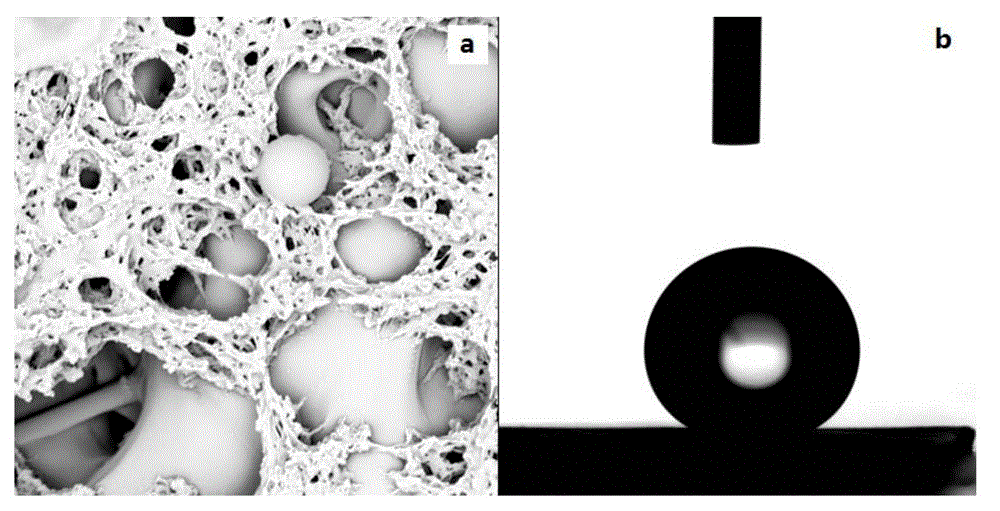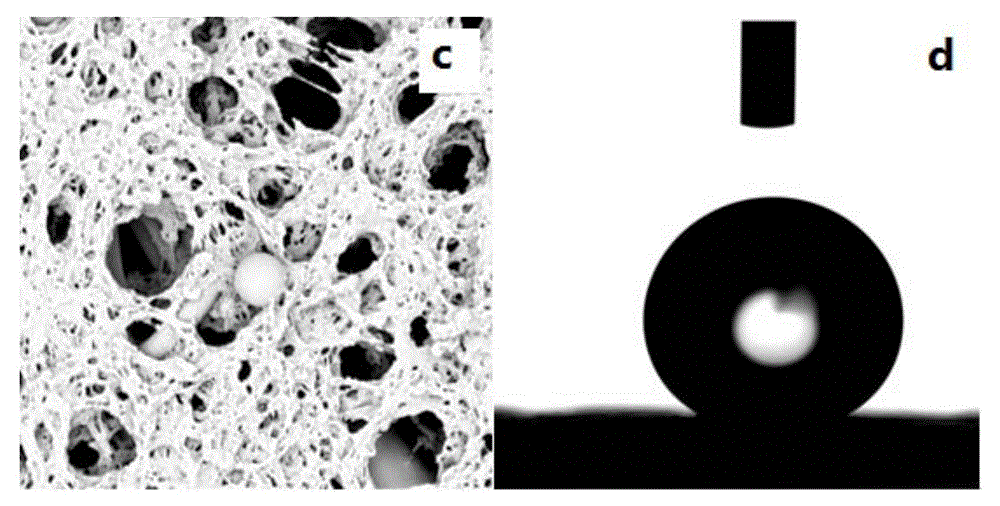Method for preparing compound polyvinylidene fluoride super-hydrophobic porous separating membrane
A polyvinylidene fluoride, porous separation membrane technology, applied in semi-permeable membrane separation, chemical instruments and methods, membrane technology, etc., can solve the problems of unsatisfactory application performance and low base membrane porosity, and achieve good permeability , the effect of increasing hydrophobicity, good strength and workability
- Summary
- Abstract
- Description
- Claims
- Application Information
AI Technical Summary
Problems solved by technology
Method used
Image
Examples
Embodiment 1
[0030] (1) The quality is respectively: polyvinylidene fluoride of 5g, polyvinyl chloride of 1g, polyethylene glycol of 1g, N,N-dimethylformamide of 93g are mixed evenly, and defoaming obtains film making liquid;
[0031] (2) Immerse the polypropylene non-woven fabric into the film-making solution obtained in step (1) for dip coating, and dip the polypropylene non-woven fabric dipped into the film-making solution through a scraper and then immerse it in a coagulation bath for curing, molding and cleaning ;
[0032] (3) Immerse the film prepared in step (2) into a fluorocarbon polymer emulsion with a mass percentage of 1% for dip coating, take out and remove the excess emulsion adsorbed on the surface, and then dry at 60°C;
[0033] (4) The membrane prepared in step (3) was heat-treated in a vacuum environment at 80°C for 4 hours, and finally a polyvinylidene fluoride superhydrophobic composite porous separation membrane was obtained, and the static contact angle of the water s...
Embodiment 2
[0035] (1) The quality is respectively: polyvinylidene fluoride of 20g, polyethersulfone of 8g, polyvinylpyrrolidone of 5g, N,N-dimethylacetamide of 67g are mixed uniformly, and defoaming obtains film making solution;
[0036] (2) Immerse the polyethylene non-woven fabric into the film-making solution obtained in step (1) for dip coating, and dip the polyethylene non-woven fabric coated with the film-making solution through a scraper and then immerse it in a coagulation bath for curing, molding and cleaning ;
[0037] (3) Immerse the film prepared in step (2) into a polydimethylsiloxane emulsion with a mass percentage of 2% for dip coating, take out and remove the excess emulsion adsorbed on the surface, and then dry it at 100°C;
[0038] (4) The membrane prepared in step (3) was heat-treated for 6 hours in a vacuum environment at 50°C, and finally a polyvinylidene fluoride superhydrophobic composite porous separation membrane was obtained, and the static contact angle of the wa...
Embodiment 3
[0040] (1) The quality is respectively: the polyvinylidene fluoride of 10g, the polysulfone of 2g, the poly(styrene-maleic anhydride) copolymer of 2g, the diethylene glycol of 3g, the trimethyl phosphate of 70g, 13gN, N -Dimethylacetamide is mixed evenly, and degassing to obtain a film-making solution;
[0041] (2) Immerse the polypropylene / polyethylene composite non-woven fabric into the film-making solution obtained in step (1) for dip coating, and then immerse the non-woven fabric dipped in the film-making solution through a scraper and then immerse it in a coagulation bath for curing and molding and cleaning;
[0042] (3) Immerse the film prepared in step (2) into a fluorocarbon polymer emulsion with a mass percentage of 5% for dip coating, take out and remove the excess emulsion adsorbed on the surface, and then dry at 90°C;
[0043] (4) The membrane prepared in step (3) was heat-treated for 5 hours in a vacuum environment at 70° C. to finally obtain a polyvinylidene flu...
PUM
 Login to View More
Login to View More Abstract
Description
Claims
Application Information
 Login to View More
Login to View More - R&D
- Intellectual Property
- Life Sciences
- Materials
- Tech Scout
- Unparalleled Data Quality
- Higher Quality Content
- 60% Fewer Hallucinations
Browse by: Latest US Patents, China's latest patents, Technical Efficacy Thesaurus, Application Domain, Technology Topic, Popular Technical Reports.
© 2025 PatSnap. All rights reserved.Legal|Privacy policy|Modern Slavery Act Transparency Statement|Sitemap|About US| Contact US: help@patsnap.com


